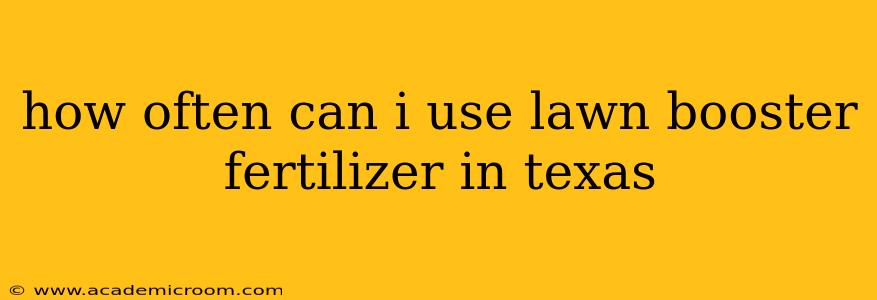How Often Can I Use Lawn Booster Fertilizer in Texas?
Texas boasts a diverse climate, with varying conditions across its regions. This means there's no single answer to how often you should use lawn booster fertilizer. The ideal frequency depends heavily on several factors, including your grass type, soil conditions, and the specific fertilizer product. Over-fertilizing can be detrimental, leading to nutrient runoff, harming the environment and potentially damaging your lawn. Under-fertilizing, on the other hand, will leave your lawn weak and vulnerable.
Let's delve deeper into the key considerations:
What Type of Grass Do You Have?
Texas lawns commonly feature Bermuda, Zoysia, St. Augustine, and Centipede grasses. Each has unique nutrient needs and growth cycles. Bermuda grass, for example, is a warm-season grass that thrives in the Texas heat, requiring more frequent fertilization during its active growth period (spring and summer). Conversely, Centipede grass has lower nutrient requirements and may only need fertilization once or twice a year. Knowing your grass type is the first crucial step.
What are the Soil Conditions in Your Yard?
A soil test is an invaluable tool. It will reveal your soil's pH level and nutrient content. This information is critical in determining the type and amount of fertilizer needed. Alkaline soils in Texas are common, impacting nutrient availability. A soil test will help you avoid unnecessary fertilizer application, preventing potential damage from nutrient imbalances.
What is the Formulation of Your Lawn Booster Fertilizer?
Different fertilizers have varying release rates. Slow-release fertilizers release nutrients gradually, reducing the need for frequent applications. Fast-release fertilizers, on the other hand, provide a quick boost but require more frequent applications. Always read and follow the instructions carefully on the fertilizer packaging for recommended application rates.
How Much Fertilizer Should I Use?
This depends entirely on your specific lawn's needs as determined by a soil test and the fertilizer product's instructions. Over-fertilizing can lead to grass burn, while under-fertilizing won't provide the necessary nutrients for healthy growth. Always follow the manufacturer's guidelines for application rates, adjusting based on your soil test results.
What is the best time of year to fertilize my lawn in Texas?
The optimal time for fertilization depends on your grass type. For warm-season grasses like Bermuda and Zoysia, fertilization is typically done in the spring and fall. Cool-season grasses might need fertilization in the fall and early spring. Avoid fertilizing during periods of extreme heat or drought, as this can stress your lawn.
How can I avoid over-fertilizing my lawn?
- Conduct a soil test: This is the most crucial step to avoid over-fertilizing.
- Follow product instructions: Carefully read and adhere to the application rates specified on the fertilizer packaging.
- Use a spreader: A spreader ensures even distribution of fertilizer, preventing concentrated areas that could burn the grass.
- Water after fertilization: Watering helps the fertilizer reach the roots and prevents burning.
- Observe your lawn: Monitor your lawn's growth and health after fertilization. If you see signs of over-fertilization (grass burn, excessive growth), adjust your application accordingly in the future.
In summary, there's no magic number for how often you should fertilize your Texas lawn. The best approach is a proactive one involving a soil test, understanding your grass type, choosing the right fertilizer, and carefully following application instructions. Remember, prevention is key to a healthy and beautiful lawn. Contact your local Texas A&M AgriLife Extension office for region-specific advice tailored to your unique circumstances.
